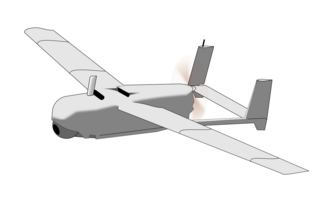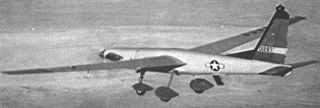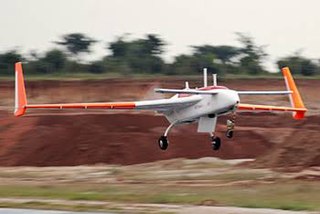
The AAI RQ-7 Shadow is an American unmanned aerial vehicle (UAV) used by the United States Army, Australian Army, Swedish Army, Turkish Air Force and Italian Army for reconnaissance, surveillance, target acquisition and battle damage assessment. Launched from a trailer-mounted pneumatic catapult, it is recovered with the aid of arresting gear similar to jets on an aircraft carrier. Its gimbal-mounted, digitally stabilized, liquid nitrogen-cooled electro-optical/infrared (EO/IR) camera relays video in real time via a C-band line-of-sight data link to the ground control station (GCS).

The Sikorsky Cypher and Cypher II are types of unmanned aerial vehicles developed by Sikorsky Aircraft. They are vertical takeoff and landing aircraft which use two opposing rotors enclosed in a circular shroud for propulsion.

The Bell Helicopter Eagle Eye, Model 918, was an American tiltrotor unmanned aerial vehicle that was offered as one of the competitors in the United States Navy's VT-UAV program.

The Boeing A160 Hummingbird is an unmanned aerial vehicle (UAV) helicopter. Its design incorporates many new technologies never before used in helicopters, allowing for greater endurance and altitude than any helicopter currently in operation.

The BAE Systems Phoenix was an all-weather, day or night, real-time surveillance Unmanned Air Vehicle. It had a twin-boom UAV with a surveillance pod, from which the imagery was data linked to a ground control station (GCS) that also controlled the aircraft in flight. It was the third generation of UAV in British Army service with the Royal Artillery after SD/1 and Canadair Midge.

The MMIST CQ-10A SnowGoose is a cargo delivery unmanned aerial vehicle that has reached IOC with the United States Armed Forces with the delivery of 15 vehicles. The SnowGoose UAV is produced by the Canadian company Mist Mobility Integrated Systems Technology (MMIST). The SnowGoose UAV is an application of MMIST's Sherpa autonomous GPS-guided parafoil delivery system and is intended for pin-point delivery of small cargo items to special forces. A fully loaded Snowgoose can carry a total of 272 kg (600 lb). The SnowGoose was originally designed for leaflet dispensing, but can support a variety of missions with its six modular cargo bays, each of which can carry pods for fuel, cargo, or electronics packages.
Shahbal is an unmanned aerial vehicle (UAV) designed by a group of aerospace engineers at Sharif University of Technology.

The Caproni Ca.101 was a three-engine Italian airliner which later saw military use as a transport and bomber. It was designed in 1927 and first flown in 1928.

The BAE Systems SkyEye is a reconnaissance UAV developed in the United States in the early 1970s by Developmental Sciences Inc, later called Developmental Sciences Corporation, a division of Lear Astronics Corporation and ultimately part of BAE Systems. Developmental Sciences Inc was one of the first US companies to investigate battlefield UAVs, flying the first prototype of the SkyEye series in 1973, leading to the first flight of the improved R4E variant in 1981. The R4E has been continuously refined since then in a sequence of subvariants.

The Ling-Temco-Vought XQM-93 was a remotely piloted aircraft developed in the United States in the late 1960s and early 1970s for use as a communications relay in the Vietnam War. A prototype flew in 1970, but the program was abandoned without producing a service-ready aircraft.
The Teledyne Ryan BQM-145 Peregrine is a reconnaissance unmanned aerial vehicle (UAV) developed in the United States in the 1990s as a joint U.S. Navy/Marine Corps and Air Force "Medium Range UAV" program, with the Navy developing the airframe and the Air Force providing the payload. The BQM-145A was designed to precede airstrike packages into a target area and relay reconnaissance information in real time.
The Silver Arrow Mini-V is a small reconnaissance UAV developed in Israel in the 1990s.

The DRDO Rustom is a Medium Altitude Long Endurance unmanned air vehicle (UAV) being developed by Defence Research and Development Organisation for the three services, Indian Army, Indian Navy and the Indian Air Force of the Indian Armed Forces. Rustom is derived from the NAL's LCRA developed by a team under the leadership of late Prof Rustom Damania in the 1980s. The UAV will have structural changes and a new engine. Rustom will replace/supplement the Heron UAVs in service with the Indian armed forces.
Kapothaka was a technology demonstrator mini-UAV for reconnaissance. The Kapothaka which means “dove” is believed to be a predecessor of Nishant UAV system.

TAI Gözcü is a radio-controlled short-range tactical drone. Designed, developed and built by Turkish Aerospace Industries (TAI), the unmanned aerial vehicle (UAV) is in use by the Turkish Armed Forces for intelligence, surveillance, target acquisition and reconnaissance purposes. Gözcü is the Turkish word for observer.
BUAA unmanned helicopters are Chinese UAVs developed by Beihang University (BUAA), some of which have entered service with the Chinese military and government establishments.
The Orion is a Medium-altitude long-endurance unmanned aerial vehicle (UAV) developed by Aurora Flight Sciences.

Bayraktar Akıncı is a High-Altitude Long-Endurance (HALE) Unmanned Combat Aerial Vehicle (UCAV) being manufactured by the Turkish technology company Baykar. The first three units entered service with the Turkish Armed Forces on 29 August 2021.

The Dynetics X-61 Gremlins is an experimental unmanned aerial vehicle designed by Dynetics.












